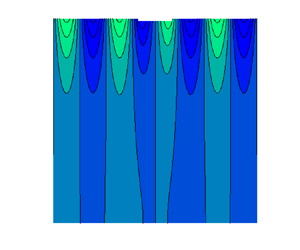1. Corrigendum
Upon more detailed inspection, figure 4 in our paper (Benham, Devauchelle & Thomson Reference Benham, Devauchelle and Thomson2024) did not provide a consistent direct comparison between the present simulation work and the predictions of Longuet-Higgins & Stewart from 1964 (associated Ref. is displayed in our paper). The analysis of Longuet-Higgins & Stewart is summarized and applied in follow-up work from 1977, and provides a quantitative prediction for the force (per unit width) associated with deep-water gravity waves on a floating body as
As such, a difference in the amplitude of the fore and aft wave emission will lead to a net wave thrust (see Ref's by Rhee et al. (2022) and Ho et al. (2023) in our paper). When one substitutes the dispersion relation for deep-water gravity waves (![]() $\omega ^2=gk$), this can be seen to be consistent with the ‘Longuet-Higgins scaling’ in the original publication (Benham et al. Reference Benham, Devauchelle and Thomson2024, Eq. (C16)), apart from the prefactor. This classical prediction is derived from first principles and goes beyond scaling, and thus provides an exact prefactor associated with the result allowing for a more direct quantitative comparison. Furthermore, the simulations underlying the original figure 4 were not in fact all conducted in the deep-water limit (i.e.
$\omega ^2=gk$), this can be seen to be consistent with the ‘Longuet-Higgins scaling’ in the original publication (Benham et al. Reference Benham, Devauchelle and Thomson2024, Eq. (C16)), apart from the prefactor. This classical prediction is derived from first principles and goes beyond scaling, and thus provides an exact prefactor associated with the result allowing for a more direct quantitative comparison. Furthermore, the simulations underlying the original figure 4 were not in fact all conducted in the deep-water limit (i.e. ![]() $kH\gg 1$) as stated. When the simulations are repeated while respecting this limit (specifically
$kH\gg 1$) as stated. When the simulations are repeated while respecting this limit (specifically ![]() $kH=4$ is sufficient), the exact prediction of Longuet-Higgins is nearly indistinguishable from the present numerical predictions as shown in figure 1 below. Henceforth, we replace figure 4 from the original paper with figure 1 herein.
$kH=4$ is sufficient), the exact prediction of Longuet-Higgins is nearly indistinguishable from the present numerical predictions as shown in figure 1 below. Henceforth, we replace figure 4 from the original paper with figure 1 herein.

Figure 1. Comparison between the numerically calculated thrust ![]() $\bar {F}_T$ and momentum flux across the domain showing close agreement between the two as well as close agreement with the prediction of Longuet-Higgins (1964) for the case of deep-water gravity waves. Surface tension and viscosity are neglected for the purpose of these calculations, with
$\bar {F}_T$ and momentum flux across the domain showing close agreement between the two as well as close agreement with the prediction of Longuet-Higgins (1964) for the case of deep-water gravity waves. Surface tension and viscosity are neglected for the purpose of these calculations, with ![]() $kH=4$ and
$kH=4$ and ![]() $500\times 500$ gridpoints in the simulations.
$500\times 500$ gridpoints in the simulations.
This new successful comparison in figure 1 suggests that the simple expressions derived in prior work by Longuet-Higgins & Stewart (see Ref. from 1964) are appropriate for application to wave-driven propulsion, provided one operates within the assumptions of the theory. Note that Longuet-Higgins & Stewart derive and provide analogous predictions to (1.1) for the more general case of capillary-gravity waves in finite depth. To the best of our knowledge, while these results have been applied to estimate wave-driven propulsive forces in several experiments (e.g. see Ref's by Pucci (2015), Roh & Gharib (2019), Rhee et al. (2022), Ho et al. (2023), Barotta et al. (2023) in our paper), direct force measurements have not been completed in this context that would likely provide additional clarity to the numerous remaining subtleties in this rich problem.
Acknowledgements
We are grateful to Mr Jack-William Barrotta and Prof Dan Harris of Brown University for pointing this error out and helping us with the present corrigendum.








